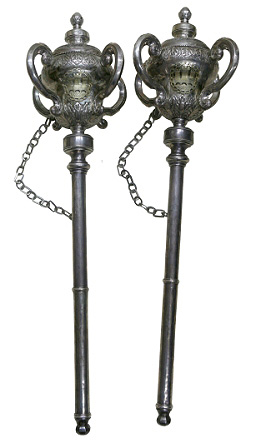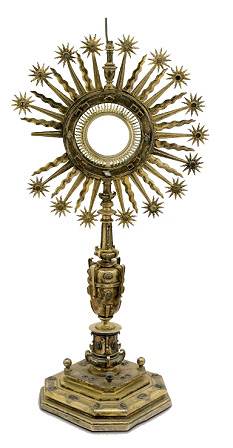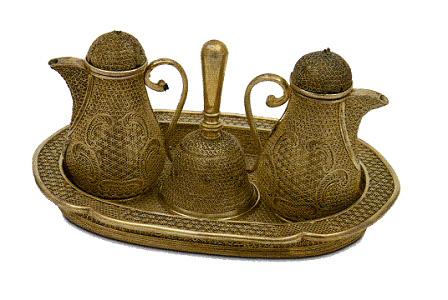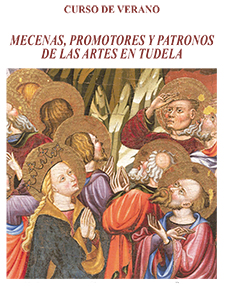PATRONS, PROMOTERS AND PATRONS OF THE ARTS IN TUDELA
August 27, 2014
Patrons and patrons of Tudela silverware
D. Ignacio Miguéliz Valcarlos. UNED Pamplona
Throughout history, there have been numerous patrons and patrons who have favored the arrival of silver pieces to the temples of Tudela. Both the documentation and the works that have come down to us tell us not only of the links between these churches and royalty, civil and ecclesiastical institutions, the nobility and the city's leading figures, but also with anonymous characters who wanted to enrich the divine cult of their saints and churches of devotion with the submission of rich gifts. We can also verify this through the inscriptions stamped on the preserved pieces themselves. In this way we see the royal house, the town hall and the Tudela town council, the religious orders settled in the city and families such as the Pasquier, the lords of Barillas, Egües, Azlor and Echeverz, San Juan, Aperregui, Castelruiz, etc...
However, in spite of the wealth that is presupposed to a city like Tudela, the issue of silver jewels that have been preserved is scarce in comparison with that of other similar cities. Likewise, there are very few existing works from the Medieval and Renaissance periods, the most numerous being those from the Baroque centuries and especially those from the 19th century. This is largely due to the terrible sacking that the city suffered on November 23, 1808, after the battle of Tudela, in which the soldiers went temple by temple and house by house looking for any object of value they could find. At this time, the temples of Tudela lost most of the jewels, the chronicles say that it was possible to buy back later some of the pieces plundered in the French camp.
Regarding the works, we have evidence of the existence of pieces from Pamplona and Zaragoza, most of which would be direct orders from the temples of Tudela, but also from Madrid, Toledo, Barcelona, Granada, Mexico and even the Holy Land. In this sense, as in the case of Navarrese silverware, the works from the Indies are of greater plastic richness than those carved in Navarrese workshops, as we can see thanks to the chalice and monstrance of the Capuchinas or the Manila set of the cathedral.
Among the jewels preserved we find pieces sent by different civil institutions, such as two chalices, from 1748 and 1827, the time of Ferdinand VI and Ferdinand VII, donated from the court to the Dominican and Capuchin nuns respectively. Or the pieces made at the request of the Tudela regiment, some of a civilian nature, such as the municipal veneras and maces, and others of a religious nature, such as the reliquaries of Saint Anne and Saint Francis Xavier. We also see pieces that arrived by way of different ecclesiastical estates, such as the chapter of the collegiate church that, together with one of its canons and the lord of Barillas, participated in the cost of the monstrance and cathedral temple, or the different canons that contributed to the enrichment of the city's temples, one of the main figures being the dean Don Pedro de Villalón y Calcena, as well as the religious orders themselves, such as the Dominican and Poor Clare orders. And finally, of great importance are the works made under patronage of individuals, such as the exceptional set of chalice and cruets sent from Manila by the Marquis of Villamediana, the Mexican chalice and monstrance given by the brothers of Mother Bernarda Sesma y Escribano, the turriform monstrance of the Montany Llopart house of Barcelona paid for in 1926 by Ambrosio Pablús Azcarate, etc...

Municipal clubs

Custody of the cathedral of Tudela

Philippine vases from the cathedral of Tudela,
sent by the Marquis of Villamediana
PROGRAM
Tuesday, 26th August
Three exceptional altarpieces for three promoters
Ms. Mercedes Jover Hernando. Museum of Navarre
The great patrons of the Renaissance, a mirror of humanism
María Concepción García Gainza. Chair of Navarrese Heritage and Art
Wednesday, 27th August
Around the patron saints
D. Ricardo Fernández Gracia
Chair of Navarrese Heritage and Art
Patrons and patrons of Tudela silverware
D. Ignacio Miguéliz Valcarlos
UNED Pamplona
Patrons and Patronages in the Collegiate ( visit guidada)
Ms. María Josefa Tarifa Castilla. University of Zaragoza
Thursday, 28th August
Town planning and civil architecture
D. Carlos Carrasco Navarro. Doctor in History of Art
The great men of the Enlightenment
D. Pablo Guijarro Salvador. Chair of Navarrese Heritage and Art.
Monarchy, patrons and nuns in the Company of Mary ( visit guided)
D. Ricardo Fernández Gracia
Chair of Navarrese Heritage and Art

